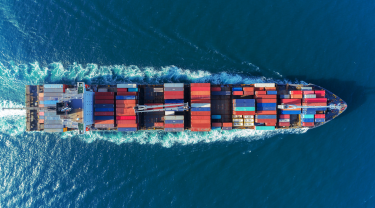Scouring the daily news is a necessary part of the job of a country risk analyst, but only provides one piece of the puzzle. Context is key in determining if current global events impact a country’s risk position.
To see the whole picture, our latest Country Risk Quarterly, an insightful, interactive tool, is informed by a review of EDC Economics’ rating actions in 2021. While 2020 saw the downgrade of more than 70 countries, the ratio of downgrades-to-upgrades was almost equal in 2021. This suggests cautious optimism that country risk has stabilized, albeit at higher than pre-COVID-19 levels.
EDC’s short-term risk rating, which measures the likelihood of commercial default for domestic counterparties over one year, is the best measure to gauge the trajectory of an economy’s recovery. This rating looks at high-frequency indicators, like inflation, economic growth, exchange rate volatility and the government’s fiscal position.
In 2021, almost 15% of all markets rated by EDC had their short-term rating upgraded. This was heavily skewed towards developed markets in Europe and Asia, which have been leading the global recovery, due to higher vaccination rates and strong fiscal support measures. We believe that this trend is likely to continue.
EDC Economics’ latest Global Economic Outlook forecasts above-trend growth for developed economies over the next two years. Among emerging markets, the picture is more mixed. The recovery of tourism-dependent economies has been further delayed by the Omicron variant, while those that rely on commodity exports will benefit from higher prices across the board.
Elevated commodity prices—a product of pent-up demand and ongoing supply chain constraints—continue to drive inflation. This will prompt central banks to rein in accommodative monetary policies, with implications on our sovereign probability of default ratings. Led by the U.S. Federal Reserve, we expect leading central banks to swing into a tightening cycle, causing borrowing costs for many governments to rise. This is a key issue, as sovereign debt has soared over the last two years.
The International Monetary Fund (IMF) estimates that about 60% of low-income countries (LICs) are at high risk of debt distress, double the number in 2015. Countries such as Argentina, Tunisia, Ghana, Sri Lanka and Egypt, which have high public and external debt, are particularly vulnerable to shifts in U.S. monetary policy. While public financing needs have fallen from the highs of 2020, they’re expected to remain well above pre-pandemic levels for emerging markets.
You should also check out
EDC interactive tool offers economic insights on Canada’s Top 75 trading partners.
The G20’s Debt Service Suspension Initiative (DSSI) was successful in providing temporary debt-service relief, helping to manage the liquidity of the poorest countries. Unfortunately, solvency has been threatened by the termination of the DSSI, at the end of 2021, and the slow implementation of its successor. This new initiative, the “Common Framework,” is complicated by the reality that China now accounts for almost two-thirds of LIC external public debt, and it remains unclear if Beijing is interested in pursuing debt restructurings. The combination of rising borrowing costs and uncertainty over debt restructurings will push some markets to the threshold of default. In the bigger picture, EDC Economics isn’t expecting a slew of sovereign defaults. For those Canadian companies not doing business with sovereigns, a deterioration in public finances will result in pressures on broader economic activity.
Of the three political risks that we rate, our political violence rating saw the most movement in 2021. Some markets were downgraded due to rising tensions, including Ukraine and Taiwan. At the geopolitical level, regional powers, like Turkey, are increasingly intervening in domestic disputes such as in Armenia or Ethiopia. One emerging trend is the resurgence of coups of democratically elected governments in West Africa. Countries are increasingly looking to the men in uniform for solutions, driven in part by popular anger over their governments’ inability to address growing insecurity from jihadist groups and weak economic development.
Another trend worth noting in our ratings is that the transfer and conversion risk, which measures the likelihood of a government enacting capital controls, has improved across Gulf countries, which have benefited from high energy prices.
The bottom line?
As the world moves past the immediate economic and political impacts of the pandemic, one of the key risks to watch will be which markets are vulnerable to rising public debt pressures. On the question of whether the world is riskier, country risks have stabilized, but have done so at a higher level. Stay informed on country risk events with EDC’s Country Risk Quarterly.
With files from Ian Tobman, manager of EDC’s Economic and Political Intelligence Centre.
This commentary is presented for informational purposes only. It’s not intended to be a comprehensive or detailed statement on any subject and no representations or warranties, express or implied, are made as to its accuracy, timeliness or completeness. Nothing in this commentary is intended to provide financial, legal, accounting or tax advice nor should it be relied upon. EDC nor the author is liable whatsoever for any loss or damage caused by, or resulting from, any use of or any inaccuracies, errors or omissions in the information provided.







